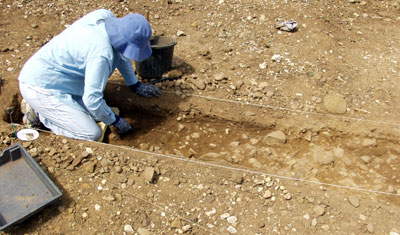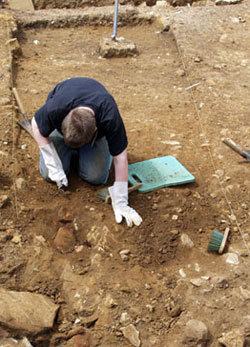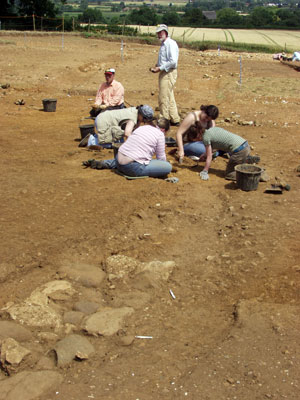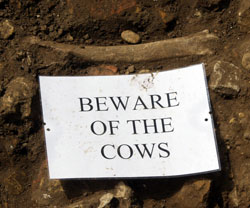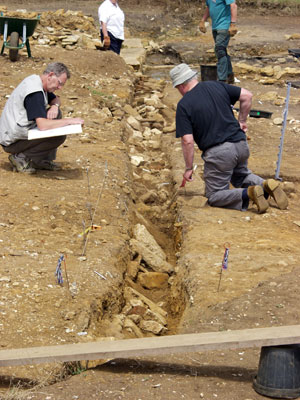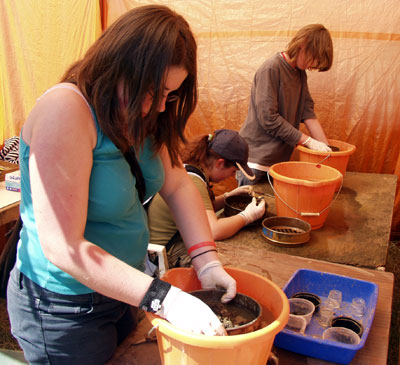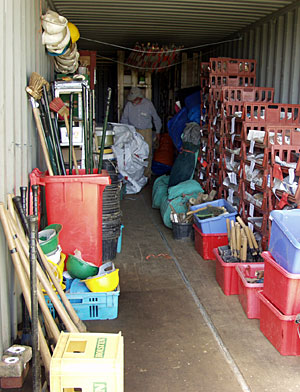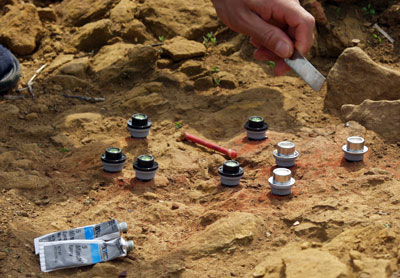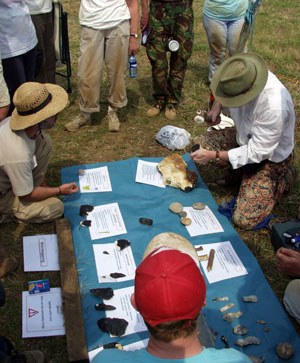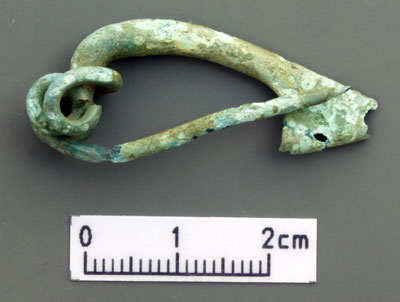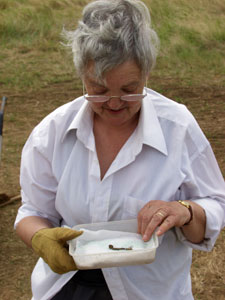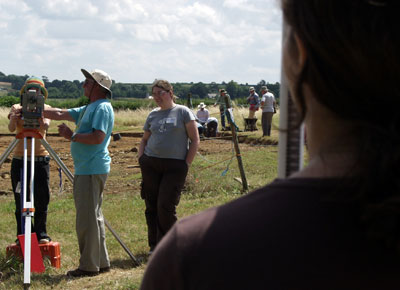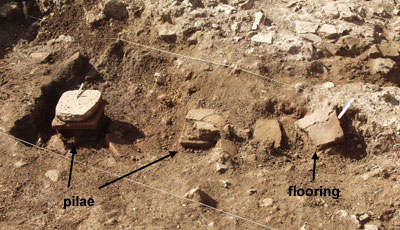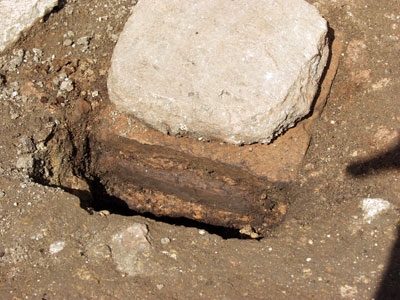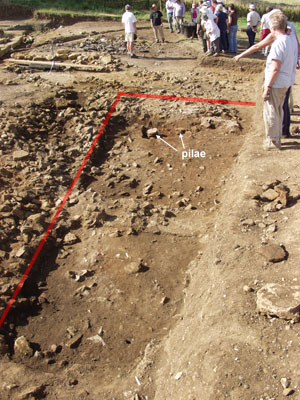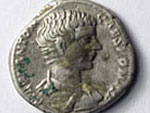 |
|
||||||
|
|
AN INFORMAL DAILY LOG (...based on the Weblog sent to the Channel 4 Time Team Big Roman Dig) WEEK 3 Day 11 of 20: Monday 11th July No report for today yet - I wasn't on site (doing paid work elsewhere!) and neither was my chief spy (Barbara has a viral infection, but hopes to be back tomorrow). I'll catch up tomorrow. Jeremy Cooper Day 12 of 20: Tuesday 12th July A mythical beast turns up! This week is definitely for getting down. We've started a trench in the courtyard...
...and two in the lower slope to see what is going on below the surfaces so far exposed.
No great discoveries yet, but a very pleasing bronze brooch (photo to come) from the lower slope. In the roundhouse they're digging a bit deeper too at the same time as troweling down the surface around the areas where the wall should be.
More pottery has been found here, including a nice fragment of decorated samian. . So, what's the mythical beast? A griffin, a harpie... While we're on the subject of animals, Moley has not yet returned to the lower slope, but we have found a horse (?) skull and a cow's leg bone.
We're also excavating the drainage ditch that runs more or less along the contour just above the lower slope. Note how the large stones all lean the same way.
More visitors today, this time year-10 students on the Aim Higher Summer School scheme. This provides a opportunities for school students to find out what it's like to be at University, to encourage them to think of working towards becoming an undergraduate. Look here for the Aim Higher web site. This group is spending three days at University College Northampton, where our site director, Steve Young, is a Senior Lecturer. They had a tour of the site with Steve and then an opportunity to work in the finds area, washing finds and sieving.
Possibly not how they thought of student life, but they seemed to be having a good time - and they tweezered out some good environmental finds! Day 13 of 20: Wednesday 13th July  Malcolm and Brigid last week Everyone basically got on with it today. Barbara is back off sick leave, and supervising the round house again, usurping her substitute, Malcolm (pictured above with Time Team's Brigid Gallagher), who gratefully returned to being a regular digger as well as supervisor in charge of tools.
As you can probably tell, I'm a bit short of creative flare today, possibly as a result of photographing a long ditch. Back on form tomorrow, I hope. Jeremy Cooper Day 14 of 20: Thursday 14th July Earth Magic Day!  Mark Noel Today we enjoyed a visit from Mark Noel, who provides an archaeo-magnetometry dating service. This is not a way for bits of old-but-attractive soil to get to know each other, but a complex way of getting a date for anything on site which was burned or well heated in romano-british times. The method is based on the changes in the earth's magnetic field: when heated enough, materials "lock in" the magnetic field of that moment.
The samples are taken stuck to a button which Mark set to be exactly level, and on which he marked direction of the sun at a particlar time - that enables Mark to calculate the declination and bearing of the sample's magnetic field. Mark compares this data with known declinations and bearings at different times in the past. It's a very complex technical and statistical operation, but it provides at best, depending on the strength of the magnetic field in the sample, a date (or small choice of dates) with an accuracy of + or - 25 years! He took samples from the stoke house where the hypocaust heating system had scorched the arches of the tunnel leading the hot air from the furnace into the hypocaust itself. He also took samples from the burnt out post pads of our post-roman timber building.
Mark was kind enough to give us all a very lucid talk about the techniques he uses on site and back in the lab on the Isle of Man. He hopes to get some results back to us in a few weeks. Watch this site! I'll add contact details for Mark's business when I have them.
At lunch time, Neil, Pete and Jo set out a superb hands-on display about flint tools and flint knapping. We hope to reproduce it here on this web site.
Work continued on the round house and lower slope, with steady progress, but no headline making news. By the way, the "horses" skull (not my idea!) turned out on excavation to be a boring sheep (or goat's) skull. Sorry. Here, at last, is the bronze fibula (brooch or clothes pin) excavated by Steve at the north end of the villa range:
That's all for now after another very hot day, but with a cooling breeze. Jeremy Cooper Day 15 of 20: Friday 15th July (The Ides of July) Room, room, give me room!* A hot sunny day with a strong breeze. Work in the roundhouse continued, with a lot of pot coming up in an area of soft ground.
Maureen found and successfully lifted a bronze fibula (brooch) nearby - unfortunately it was broken long before she uncovered it. She's an experienced digger (mainly at nearby Piddington) but had never found a bronze object before. For a close up of the fibula, see week 4, day 18. Meanwhile, Jeff, a very welcome returnee Time Team volunteer, has at last learned (Barbara has her methods) to resist the temptation to remove pieces of pot from a section.... Jeff... JEFF... don't do that... phew!
Amy, Holly and Clara took time out from digging in the round house to have a lesson in using the theodolite from volunteer Colin, a retired surveyor with a distinctive hat.
Down on the lower slope the day ended very dramatically with the unearthing of several pilae - the short pillars, made of stacks of tiles, which held up the floor in a room with a hypocaust providing under floor heating! There was a bit of floor surface too.
So this was a room, probably one of a suite of rooms disappearing under the baulk - another unwritten law of archaeology (remember them ?) is that "all the information is under the baulk, or the spoil heap": we have managed to combine both in this case!
From the pottery found we know that it was almost certainly an earlier building than the bath house - perhaps a previous bath house, or even another villa. Next week - our last this year -may see an answer to the mystery - or it may not! Watch this space. Have a good weekend. Jeremy Cooper * Common opening of Mummers Plays: "Room, room, give me room to rhyme...". What's mumming, I hear you ask: click here (for example). |
||||||
|
